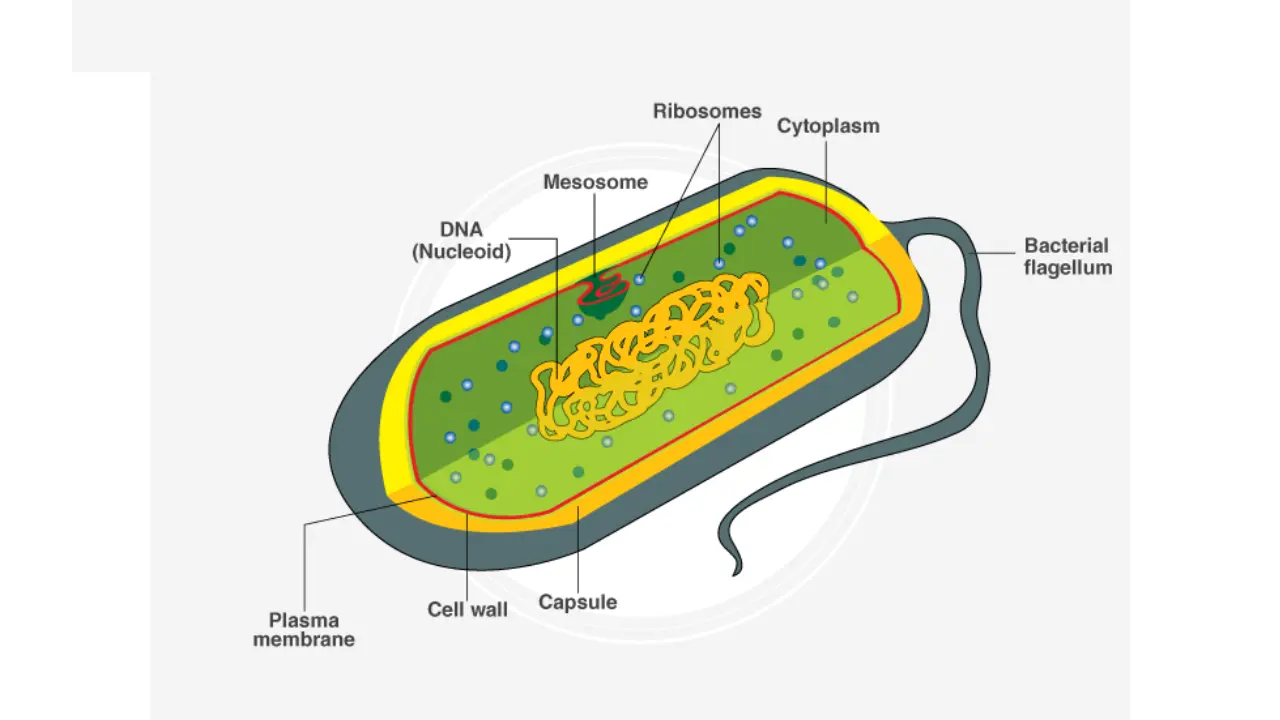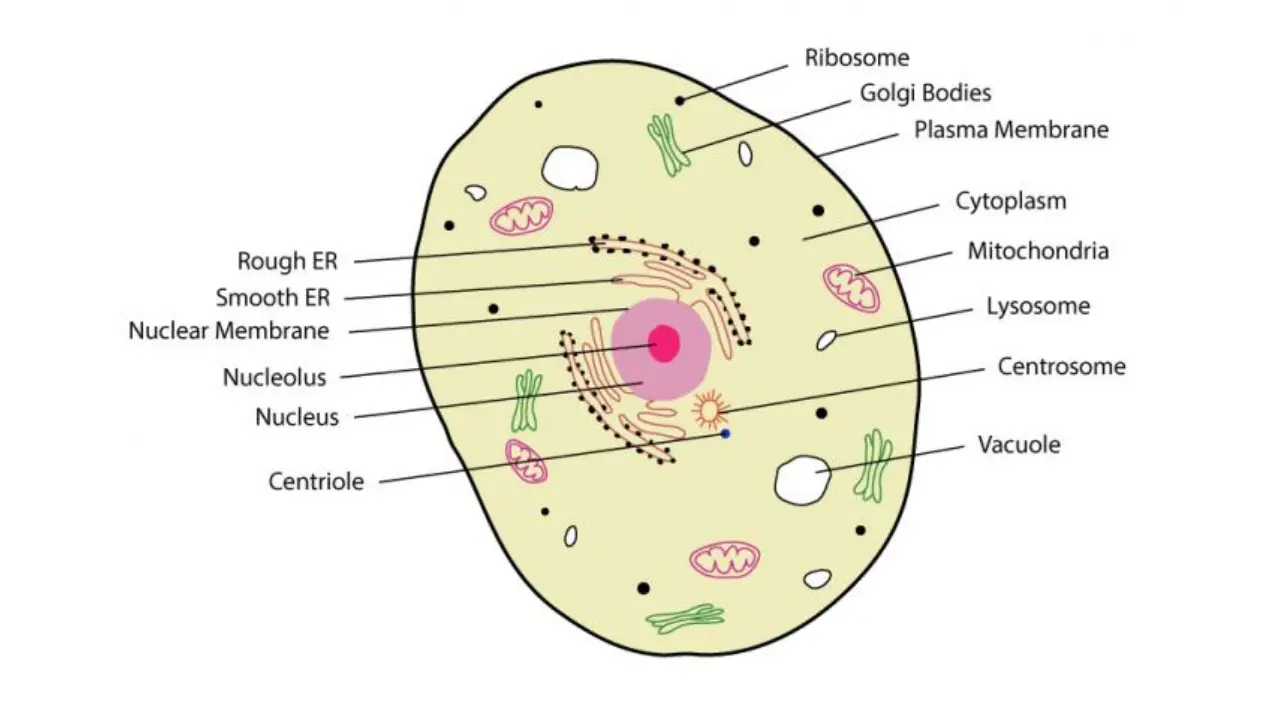All living things are made up of cells, the basic units of life. There are two main types of cells: Prokaryotic cells and Eukaryotic cells.
Prokaryotic Cell
- Definition: A prokaryotic cell is a simple, small cell without a nucleus or membrane-bound organelles. Found in bacteria and archaea, it has a nucleoid region containing DNA, a cell wall, a plasma membrane, ribosomes, and sometimes a capsule and flagella.
- Examples: Bacteria and archaea.
- Characteristics:
- No Nucleus: The genetic material (DNA) is not enclosed in a nucleus. It is found in a region called the nucleoid.
- Simple Structure: Lacks membrane-bound organelles like mitochondria or chloroplasts.
- Cell Wall: Most prokaryotic cells have a cell wall that provides shape and protection.
- Reproduction: Reproduces mainly through binary fission, a simple form of cell division.
Prokaryotic Cell Diagram

This diagram shows the structure of a prokaryotic cell, specifically a bacterial cell. The labeled parts include the following:
- Capsule: The outermost layer is a protective coating found in some bacteria. It helps protect the cell from dehydration and phagocytosis (engulfment by other cells) and aids in surface attachment.
- Cell Wall: A rigid layer just inside the capsule. It provides structural support and shape to the cell. In bacteria, it is made up of peptidoglycan.
- Plasma Membrane: A flexible lipid bilayer located just beneath the cell wall. It controls the movement of substances in and out of the cell, thus maintaining the internal environment.
- Cytoplasm: The gel-like substance filling the inside of the cell. It contains all the cell’s internal components and is the site where many metabolic reactions occur.
- DNA (Nucleoid): The region in the cell where the circular DNA molecule is located. It contains the genetic material of the cell, which controls all cellular activities and replication.
- Ribosomes: Small structures scattered throughout the cytoplasm. They are the sites of protein synthesis where genetic information is translated into proteins.
- Mesosome: Folded extensions of the plasma membrane. They are believed to be involved in cell division and distribution of DNA to daughter cells, and also play a role in respiration and increasing the surface area for enzyme attachment.
- Bacterial Flagellum: A long, whip-like structure extending from the cell surface. It provides motility to the bacterial cell, allowing it to move towards favorable environments and away from harmful ones.
Eukaryotic Cell
- Definition: A eukaryotic cell is a complex, larger cell with a nucleus and membrane-bound organelles. Found in plants, animals, fungi, and protists, it includes organelles like mitochondria, endoplasmic reticulum, Golgi apparatus, and, in plants, chloroplasts, along with a well-defined nucleus.
- Examples: Plants, animals, fungi, and protists.
- Characteristics:
- Nucleus: Contains the genetic material (DNA) enclosed within a nuclear membrane.
- Complex Structure: Has various membrane-bound organelles like mitochondria, endoplasmic reticulum, Golgi apparatus, and, in plant cells, chloroplasts.
- Cell Wall: Plant cells and fungi have a cell wall; animal cells do not.
- Reproduction: Reproduces through mitosis (for growth and maintenance) and meiosis (for sexual reproduction).
Eukaryotic Cell Diagram

Eukaryotic cells are more complex than prokaryotic cells and have membrane-bound organelles that perform specific functions. Here are the parts labeled in the diagram:
- Nucleus: The nucleus is the central organelle of the cell and contains the genetic material (DNA) that instructs the cell on how to function and reproduce. The nucleus is surrounded by a nuclear membrane, which separates it from the cytoplasm.
- Nucleolus: The nucleolus is a region inside the nucleus that is responsible for producing ribosomes.
- Ribosomes: Ribosomes are small organelles that are responsible for protein synthesis. They are found throughout the cytoplasm and on the rough endoplasmic reticulum.
- Golgi apparatus (Golgi bodies): The Golgi apparatus is an organelle that packages, modifies, and transports materials throughout the cell.
- Plasma membrane: The plasma membrane is the outer boundary of the cell and controls what enters and leaves the cell.
- Cytoplasm: The cytoplasm is the jelly-like substance that fills the cell and contains all of the cell’s organelles except for the nucleus.
- Endoplasmic reticulum (ER): The endoplasmic reticulum is a network of membranes that is involved in protein synthesis, lipid synthesis, and detoxification. There are two types of ER: rough ER and smooth ER. Rough ER has ribosomes attached to its surface, while smooth ER does not.
- Mitochondria: Mitochondria are known as the powerhouse of the cell. They are responsible for cellular respiration, which is the process of converting glucose into energy.
- Vacuoles: Vacuoles are storage sacs that can store water, nutrients, and waste products.
- Centrioles: Centrioles are organelles that help with cell division. They are located near the nucleus.
Difference Between Prokaryotic and Eukaryotic Cell
| Feature | Prokaryotic Cell | Eukaryotic Cell |
|---|---|---|
| Nucleus | No nucleus | Has a nucleus |
| Size | Smaller (1-10 micrometers) | Larger (10-100 micrometers) |
| Complexity | Simple structure | Complex structure |
| DNA | Circular, found in nucleoid | Linear, enclosed in a nucleus |
| Organelles | No membrane-bound organelles | Contains membrane-bound organelles |
| Cell Division | Binary fission | Mitosis and meiosis |
| Cell Wall | Present (contains peptidoglycan in bacteria) | Present in plants and fungi (contains cellulose in plants and chitin in fungi); absent in animal cells |
| Ribosomes | Smaller (70S) | Larger (80S) |
| Cytoskeleton | Absent or very simple | Present and complex |
| Examples | Bacteria, Archaea | Plants, Animals, Fungi, Protists |
| Reproduction | Asexual reproduction only (binary fission) | Both asexual (mitosis) and sexual (meiosis) reproduction |
| Flagella | Simple, composed of flagellin | Complex, composed of microtubules |
Key Differences
- Nucleus: Prokaryotic cells lack a nucleus; eukaryotic cells have a nucleus.
- Size: Prokaryotic cells are generally smaller (1-10 micrometers) than eukaryotic cells (10-100 micrometers).
- Organelles: Prokaryotic cells do not have membrane-bound organelles; eukaryotic cells do.
- DNA Structure: Prokaryotic DNA is circular and not associated with histones(a protein that provides structural support for a chromosome); eukaryotic DNA is linear and associated with histones.